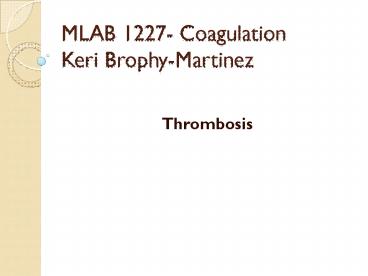MLAB 1227 Coagulation Keri BrophyMartinez - PowerPoint PPT Presentation
1 / 19
Title:
MLAB 1227 Coagulation Keri BrophyMartinez
Description:
Imbalances between clotting activity and fibrinolytic processes ... Antithrombin III deficiency. ATIII binds thrombin to inhibit coagulation. ... – PowerPoint PPT presentation
Number of Views:53
Avg rating:3.0/5.0
Title: MLAB 1227 Coagulation Keri BrophyMartinez
1
MLAB 1227- CoagulationKeri Brophy-Martinez
- Thrombosis
2
Thrombosis
- Imbalances between clotting activity and
fibrinolytic processes - Causes increased tendency to form thrombi
- Involves the naturally occurring inhibitors of
coagulation (those that control the amount of
clotting) where the clots can form, but
uncontrollably - More than one hemostatic defect or abnormality
increases risk
3
Terms
- Hypercoagulation more clotting activity than
normal - Thrombosis formation of platelet and/or fibrin
mass in a vessel - Thrombus fibrin mass consisting of fibrin,
platelets and trapped cells - Embolus piece of thrombotic material
- Embolism obstruction in circulatory system
caused by embolus
4
Terms cont
- Plaque consists of lipids, fibrous connective
tissue, macrophages and smooth muscle cells - Thrombophlebitis thrombus of superficial veins
of legs self-limiting and benign - Deep vein thrombosis involvement of deep veins
of legs - Thrombophilia any disorder associated with an
increased tendency to cause venous thromboembolism
5
Thrombus Formation
- Two types
- Arterial
- Venous
6
Arterial Thrombus Formation
- Occurs when activation of blood coagulation
exceeds ability of the anticoagulant/inhibitors
and fibrinolytic system to prevent the formation
of fibrin. - White thrombi composed of platelets, fibrin and a
few WBCs and RBCs - Form at areas where the flow has been disturbed
via damage to endothelium, especially
atherosclerotic plaques
7
Arterial Thrombus Formation
- Thrombosis initiated by rupture of the plaque,
exposing material to subendothelium in the blood - Causes platelet plasma coagulation factor
activation which results in fibrin formation.
The end result is a thrombus that can obstruct
the artery or an embolus breaks off and lodges in
the heart or brain, causing tissue death
8
Arterial Thrombus Formation
- Risk factors associated with plaque formation
- Hypercholesterolemia
- Hypertension
- Smoking
- Physical inactivity
- Obesity
- Diabetes
9
Venous Thrombi
- Occurs when activation of blood coagulation
exceeds ability of the anticoagulant/inhibitors
and fibrinolytic system to prevent the formation
of fibrin. - Most occur in veins in lower limbs
10
Venous Thrombi
- Red thrombi
- Form in veins
- Composed of rbcs trapped in fibrin mesh with few
platelets and WBCs - Form in areas of slow or disturbed blood flow,
where venous segments have been exposed to direct
trauma
11
Venous Thrombi
- Risk factors associated with venous thrombosis
- Venous stasis
- Vessel wall damage
- Factor V leiden and protein C resistance
- Deficiency of AT3, Protein C, Protein S, heparin
cofactor II - Increased PT levels
- Antiphospholipid antibodies
- Hyperhomocysteinemia
- Decreased fibrinolytic activity
- Malingnancy
- Misc( those associated with plaque formation,
pregnancy and oral contraceptive use)
12
Thrombophilia
- 2nd most common cause of death
- Inherited or acquired
13
Inherited
- Predisposing genetic defect that results in a
tendency to thrombose - Changes involve an increase in procoagulant
potential, a defect of decrease in natural
inhibitors and/ or abnormalities of fibrinolysis
or platelet activation
14
Inherited Clinical Presentation
- Venous thromboembolis prior to age 45
- Recurrent VTE
- Family history of VTE
- Thrombosis in an unusual site (cervical/ visceral
veins)
15
Inherited States Associated with Thrombosis
- Antithrombin III deficiency
- ATIII binds thrombin to inhibit coagulation.
When deficient thrombin may uncontrollably
convert fibrinogen to fibrin clots. - Deficiency of Protein C or S
- Protein C and S work together to inactivate
factors V and VIIIC to control the amount of
coagulation occurring. A deficiency of either
will result in increased chance of thrombi or
emboli.
16
Inherited States Associated with Thrombosis
- Factor V Leiden
- Genetic mutation of factor V which causes
resistance to the action of Protein C - Factor II 20210 mutation
- Problem with Protein C or S
- Dysfibrinogenemia
- Structurally altered fibrinogen molecule
17
Acquired States
- Antiphospholipid Antibody Syndrome
- Includes the lupus anticoagulant, anticardiolipin
antibodies and others are antibodies that prolong
phospholipid dependent clotting assays in vitro - Patients show no bleeding disorder
- Malignancy
- Pregnancy Oral Contraceptives
- Postoperative States
- Hematologic Disorders
18
Antithrombotic Therapy
- Goal is to treat or prevent thrombosis
19
Antithrombotic Therapy 3 Categories
- Antiplatelet Drugs
- Aspirin
- Inhibits the formation of thromboxane A2
- Anticoagulant Drugs
- Heparin
- binds to AT3 to produce an anticoagulant effect
- Oral Anticoagulant
- Coumadin drugs interfer with vitamin K action of
the liver - Thrombolytic Drugs
- Plasminogen activators are used to lyse thrombi
in vivo































